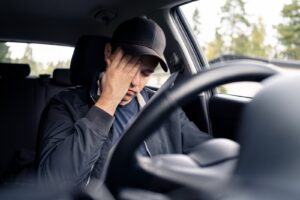Narcolepsy: Causes, Symptoms, & Treatments
What it is, its causes, and the steps that can help manage it
- Narcolepsy affects the brain’s ability to regulate sleep-wake cycles and causes persistent daytime sleepiness.
- Additional symptoms include disrupted sleep, sleep paralysis, and sleep-related hallucinations.
- Treatment for narcolepsy focuses on managing symptoms and reducing accident risk.
Narcolepsy is a sleep disorder that is often misunderstood. It is characterized by severe and persistent drowsiness that can cause impairments in school, work, and social settings as well as heighten the risk of serious accidents and injuries.
Although rare in comparison to many other sleep disorders, narcolepsy affects hundreds of thousands of Americans, including both children and adults.
Understanding the types of narcolepsy and their symptoms, causes, diagnosis, and treatment can empower people to manage it more effectively.
Is Your Troubled Sleep a Health Risk?
A variety of issues can cause problems sleeping. Answer three questions to understand if it’s a concern you should worry about.
What Is Narcolepsy?
Narcolepsy is a disorder that disrupts sleep-wake processes. This disruption can cause excessive sleepiness, the primary symptom of narcolepsy, and make it hard for people with narcolepsy to stay awake for long periods of time.
Normal sleep unfolds through a series of stages, with rapid eye movement (REM) sleep occurring in the final stage, usually an hour or more after falling asleep. In narcolepsy, changes in the brain disrupt how sleep works. As a result, REM sleep is irregular and often begins within minutes after falling asleep, which is much earlier than normal. The inability to properly regulate the sleep cycle can lead to serious problems during the day.
According to the International Classification of Sleep Disorders, Third Edition (ICSD-3), there are two types of narcolepsy: narcolepsy type 1 (NT1) and type 2 (NT2).
Narcolepsy Type 1
NT1 is associated with the symptom of cataplexy, which is the sudden loss of muscle tone. However, not everyone who is diagnosed with NT1 experience episodes of cataplexy. NT1 can also be diagnosed when a person has low levels of hypocretin-1, a chemical in the body that helps control wakefulness.
Even when not present at diagnosis, cataplexy eventually occurs in a significant number of people with low levels of hypocretin-1.
Narcolepsy Type 2
People with NT2 have many similar symptoms as people with NT1, but they do not have cataplexy or low levels of hypocretin-1. Other sleep disorders also have similar symptoms to those found in NT2, which can make it hard to diagnose.
If a person with NT2 later develops cataplexy or low hypocretin-1 levels, their diagnosis can be reclassified as NT1.
How Common Is Narcolepsy?
Narcolepsy is relatively rare. NT1 affects between 20 and 67 people per 100,000 in the United States. According to a population based study in Olmstead county Minnesota, NT1 is two to three times more common than NT2, which is estimated to affect between 20 to 67 people per 100,000.
Calculating the prevalence of narcolepsy is challenging because of underdiagnosis and delays in diagnosis. Many people are not diagnosed with narcolepsy until years after their first symptoms . As a result, some estimates place the prevalence of narcolepsy as high as 180 per 100,000.
Narcolepsy occurs roughly equally in men and women and can affect both children and adults. It can occur at any age, but onset has been found to peak at around age 15 and again around age 35.
Narcolepsy Symptoms
The symptoms of narcolepsy can have notable effects during both daytime and night time. The most common symptoms include:
- Excessive daytime sleepiness (EDS): EDS involves an urge to sleep that can feel irresistible, and it arises most frequently in monotonous situations. Severe drowsiness often causes lapses in attention and “sleep attacks” which involve falling asleep without warning.
- Automatic behaviors: Trying to avoid sleepiness can trigger automatic behaviors that occur while a person is unaware. For example, a student in class may continue writing but is actually just scrawling lines or gibberish on the page.
- Disrupted nighttime sleep: Sleep fragmentation is common in people with narcolepsy who may awaken multiple times during the night. Other bothersome sleep problems like excess physical movements and sleep apnea are also more common in narcoleptics.
- Sleep paralysis: People with narcolepsy have a higher rate of sleep paralysis, which is a feeling of being unable to move that occurs while falling asleep or waking up.
- Sleep-related hallucinations: Vivid imagery can occur while falling asleep (hypnagogic hallucinations) or when waking up (hypnopompic hallucinations). This may accompany sleep paralysis, which can be particularly disturbing or frightening.
- Cataplexy: Cataplexy is a sudden loss of muscle control. It only occurs in people with NT1. An episode of cataplexy often occurs in response to sudden emotions like laughter or excitement. Cataplexy normally affects both sides of the body and lasts for a few seconds to a few minutes. Some people only have episodes of cataplexy a few times per year, while others can have a dozen or more episodes per day.
Although all people with narcolepsy have EDS, less than a quarter have all of these symptoms. In addition, the symptoms may not occur simultaneously. For example, it’s not uncommon for cataplexy to begin years after a person has started to have EDS.
Are Narcolepsy Symptoms Different In Children?
In children, EDS is more likely to appear as restlessness or irritability, which may be interpreted as a behavior problem. At night, children with narcolepsy may sleep longer and have more active body movements during sleep .
Cataplexy is often more subtle in children, although it occurs in up to 80% of cases . It commonly involves the face rather than the body and may be perceived as a facial tic. Over time, cataplexy symptoms in children evolve to their more traditional form.

What Are the Effects of Narcolepsy?
People with narcolepsy are at higher risk of other health conditions including cardiovascular problems like high blood pressure, and psychiatric issues like depression, anxiety, and attention-deficit/hyperactivity disorder (ADHD).
Accidents are a pressing concern as drowsiness, sleep attacks, and cataplexy can be life-threatening when driving or wherever safety is critical. It is estimated that people with narcolepsy are three to four times more likely to be involved in a car accident.
Narcolepsy can also interfere with school and work. Sleepiness and pauses in attention can harm performance and may be interpreted as behavioral problems, especially in children. Many people with narcolepsy feel stigma related to the condition that can lead to social withdrawal. Without proper support, this may contribute to mental health disorders and negatively affect school, work, and relationships.
What Causes Narcolepsy?
Research has started to reveal details about the underlying nature of narcolepsy. But even with growing knowledge, the exact causes and risk factors for each type are not fully understood.
NT1
Narcolepsy type 1 is identified by the loss of neurons in the brain that are responsible for making hypocretin, also known as orexin, a chemical that helps regulate wakefulness and sleep. People with NT1 have a loss of 90% or more of the normal amount of hypocretin-making neurons.
A genetically susceptible individual may experience damage to these neurons in an autoimmune fashion after an environmental trigger. Based on this data, one theory about NT1 is that an external factor triggers the immune system to attack the brain’s neurons that make hypocretin. However, this autoimmune response inconsistently occurs and therefore is not the only cause.
Researchers have found that as many as 98% of people with NT1 carry a gene variation known as DQB1*0602 . This gene variation could cause a genetic susceptibility to NT1, but it is not yet definitively proven .
Even though researchers know more than ever about NT1, most individual cases still occur with no clear, direct cause. People with a family history of NT1 have about a 1-2% chance of developing the condition. In rare cases, NT1 occurs because of another medical condition that causes damage to the parts of the brain containing hypocretin-producing neurons. This may be known as secondary narcolepsy, and it can occur from brain trauma or an infection in the central nervous system.
NT2
Little is known about the biology of or risk factors for NT2. Some experts believe that NT2 is simply a less pronounced loss of hypocretin-producing neurons. Others think NT2 may primarily be a precursor to NT1, but cataplexy has only been observed to develop in about 10% of cases of people initially diagnosed with NT2.
In some instances, NT2 has been reported following a viral infection, but most cases do not have an established cause. As with NT1, NT2 can arise because of other medical conditions such as head trauma, multiple sclerosis, and other diseases affecting the brain.
Narcolepsy Diagnosis
Diagnosis of narcolepsy requires careful analysis by a specialist. Because it is rare and symptoms may be mistakenly attributed to other causes, narcolepsy can go undiagnosed for many years.
The diagnostic process starts with a review of symptoms and medical history. This step helps the doctor understand the patient’s sleep habits and the nature of their symptoms. In many cases, family members are involved in order to provide more context about a person’s symptoms.
Polysomnography (PSG), a detailed test in which sensors monitor brain and body activity overnight in a specialized clinic, may be necessary to evaluate a person’s sleep architecture. The Multiple Sleep Latency Test (MSLT) may also be used to objectively assess sleepiness and how quickly REM sleep begins. During the MSLT, a subject will try to fall asleep at five different intervals while connected to sensors used in the PSG.
A lumbar puncture procedure may be done to remove cerebrospinal fluid (CSF) and assess its level of hypocretin. Low levels of hypocretin are indicative of NT1 and help distinguish it from NT2.
Diagnostic Criteria for Narcolepsy
Doctors follow standardized criteria for diagnosing sleep disorders. Standardization helps ensure accurate diagnosis and differentiation between NT1, NT2, and other hypersomnias.
Criteria for NT1 and NT2 both require significant EDS that lasts for at least three months. For NT1, a person must have low levels of hypocretin in their CSF or have cataplexy symptoms, as well as a short time to enter REM sleep on the MSLT. For NT2, a person must have similar results on the MSLT, but they without cataplexy or low levels of hypocretin. Although not enough for a diagnosis, the presence of brief, refreshing naps and interrupted nighttime sleep can help distinguish narcolepsy from other conditions.
Narcolepsy Treatments
There is no cure for narcolepsy type 1 or type 2. The goals of treatment for narcolepsy are improving symptoms, reducing risks, and enhancing quality of life.
For many people, narcolepsy remains generally stable over time. In some cases, certain symptoms may improve over time, and rarely, remission of symptoms may happen spontaneously. So far, experts do not know why the disease unfolds differently in different people.
A combination of medical and behavioral approaches can significantly decrease symptoms, although some level of EDS normally persists despite treatment. All therapies should be carried out under the guidance of a doctor who can best tailor a treatment plan to a person’s specific situation.
Behavioral Approaches to Treatment
Behavioral approaches are non-medical forms of therapy, and there are multiple ways that they can be incorporated into the daily habits of people with narcolepsy.
- Planning short naps: Because brief naps are refreshing for people with narcolepsy, budgeting time for naps during the day can reduce EDS. Accommodations at school or work may be necessary to make time for naps.
- Having healthy sleep hygiene: To combat poor sleep at night, people with narcolepsy can benefit from good sleep habits. Good sleep hygiene includes a consistent sleep schedule, a sleep environment with minimal distractions, and limited use of electronic devices before bed.
- Avoiding alcohol and other sedatives: Any substance that contributes to sleepiness may worsen daytime narcolepsy symptoms.
- Driving with caution: People with narcolepsy should talk with the doctor about safe driving. Measures to improve safety could include napping before driving and avoiding long drives.
- Exercising and eating a balanced diet: People with narcolepsy have a higher risk of obesity, which makes exercise and eating well an important part of their overall health.
- Seeking support: Support groups and mental health professionals can promote emotional health and counteract the risks of social withdrawal, depression, and anxiety in people with narcolepsy.
Medications
Although behavioral approaches are frequently helpful, medications for narcolepsy often provide symptom improvement. These drugs require a prescription and should be used carefully and according to the instructions provided by a doctor and pharmacist:
- Modafinil and armodafinil: These two wakefulness-promoting drugs are chemically similar and are typically the first therapy for EDS.
- Methylphenidate: This is a type of amphetamine that can reduce EDS.
- Solriamfetol: This drug was approved by the FDA in 2019 and has shown comparable effects on EDS as modafinil .
- Sodium oxybate: This medication can reduce cataplexy, EDS, and nighttime sleep disturbances, but it may take weeks to affect EDS .
- Pitolisant: Approved by the FDA in 2019, pitolisant is a wakefulness-promoting medication that has also shown a positive effect on cataplexy.
Not all medications work for all patients. Working closely with the doctor can help identify the medication and dosage with the best balance of benefits and downsides.
Narcolepsy Treatment and Children
Treatment for children with narcolepsy is similar to treatment in adults, but additional precautions may be taken when choosing medications and their dosages. A cardiovascular evaluation is recommended by the American Academy of Pediatrics before children start taking stimulant medications.
Narcolepsy Treatment and Pregnancy
There is limited data about the safety of most drugs used to treat narcolepsy in women who are pregnant, trying to get pregnant, or breastfeeding. A survey found that the majority of experts recommend stopping narcolepsy medications when trying to conceive as well as when pregnant and breastfeeding. Discontinuing medication may require changes to behavioral approaches and other accommodations to safely cope with symptoms without medication.
References
16 Sources
-
American Academy of Sleep Medicine. (2014). International Classification of Sleep Disorders — Third Edition (ICSD-3) (Online).
https://aasm.org/ -
Pérez-Carbonell, L., & Leschziner, G. (2018). Clinical update on central hypersomnias. Journal of Thoracic Disease, 10(S1), S112–S123.
https://pubmed.ncbi.nlm.nih.gov/29445535/ -
Silber, M. H., Krahn, L. E., Olson, E. J., & Pankratz, V. S. (2002). The epidemiology of narcolepsy in Olmsted County, Minnesota: A population-based study. Sleep, 25(2), 197–202
https://pubmed.ncbi.nlm.nih.gov/11902429/ -
Thorpy, M. J., & Krieger, A. C. (2014). Delayed diagnosis of narcolepsy: Characterization and impact. Sleep Medicine, 15(5), 502–507.
https://pubmed.ncbi.nlm.nih.gov/24780133/ -
Pizza, F., Franceschini, C., Peltola, H., Vandi, S., Finotti, E., Ingravallo, F., Nobili, L., Bruni, O., Lin, L., Edwards, M. J., Partinen, M., Dauvilliers, Y., Mignot, E., Bhatia, K. P., & Plazzi, G. (2013). Clinical and polysomnographic course of childhood narcolepsy with cataplexy. Brain: A Journal of Neurology, 136(Pt 12), 3787–3795.
https://pubmed.ncbi.nlm.nih.gov/24142146/ -
Antelmi, E., Pizza, F., Vandi, S., Neccia, G., Ferri, R., Bruni, O., Filardi, M., Cantalupo, G., Liguori, R., & Plazzi, G. (2017). The spectrum of REM sleep-related episodes in children with type 1 narcolepsy. Brain: A Journal of Neurology, 140(6), 1669–1679.
https://pubmed.ncbi.nlm.nih.gov/28472332/ -
Challamel, M. J., Mazzola, M. E., Nevsimalova, S., Cannard, C., Louis, J., & Revol, M. (1994). Narcolepsy in children. Sleep, 17(8 Suppl), S17-20.
https://pubmed.ncbi.nlm.nih.gov/7701194/ -
McCall, C. A., & Watson, N. F. (2020). Therapeutic strategies for mitigating driving risk in patients with narcolepsy. Therapeutics and Clinical Risk Management, 16, 1099–1108.
https://pubmed.ncbi.nlm.nih.gov/33209031/ -
Abad, V. C., & Guilleminault, C. (2017). New developments in the management of narcolepsy. Nature and Science of Sleep, 9, 39–57.
https://pubmed.ncbi.nlm.nih.gov/28424564/ -
Ollila, H. M. (2020). Narcolepsy type 1: What have we learned from genetics? Sleep, 43(11), zsaa099.
https://pubmed.ncbi.nlm.nih.gov/32442260/ -
Tafti, M., Hor, H., Dauvilliers, Y., Lammers, G. J., Overeem, S., Mayer, G., Javidi, S., Iranzo, A., Santamaria, J., Peraita-Adrados, R., Vicario, J. L., Arnulf, I., Plazzi, G., Bayard, S., Poli, F., Pizza, F., Geisler, P., Wierzbicka, A., Bassetti, C. L., … Kutalik, Z. (2014). DQB1 locus alone explains most of the risk and protection in narcolepsy with cataplexy in Europe. Sleep, 37(1), 19–25.
https://pubmed.ncbi.nlm.nih.gov/24381371/ -
Fronczek, R., Arnulf, I., Baumann, C. R., Maski, K., Pizza, F., & Trotti, L. M. (2020). To split or to lump? Classifying the central disorders of hypersomnolence. Sleep, 43(8).
https://pubmed.ncbi.nlm.nih.gov/32193539/ -
Thorpy, M. J. (2020). Recently approved and upcoming treatments for narcolepsy. CNS Drugs, 34(1), 9–27.
https://pubmed.ncbi.nlm.nih.gov/31953791/ -
Sonka, K., & Susta, M. (2012). Diagnosis and management of central hypersomnias. Therapeutic Advances in Neurological Disorders, 5(5), 297–305.
https://pubmed.ncbi.nlm.nih.gov/22973425/ -
Wolraich, M. L., Hagan, J. F., Allan, C., Chan, E., Davison, D., Earls, M., Evans, S. W., Flinn, S. K., Froehlich, T., Frost, J., Holbrook, J. R., Lehmann, C. U., Lessin, H. R., Okechukwu, K., Pierce, K. L., Winner, J. D., Zurhellen, W., & Subcommittee on Children and Adolescents with Attention-Deficit/Hyperactive Disorder. (2019). Clinical practice guideline for the diagnosis, evaluation, and treatment of attention-deficit/hyperactivity disorder in children and adolescents. Pediatrics, 144(4).
https://pubmed.ncbi.nlm.nih.gov/31570648/ -
Thorpy, M., Zhao, C. G., & Dauvilliers, Y. (2013). Management of narcolepsy during pregnancy. Sleep Medicine, 14(4), 367–376.
https://pubmed.ncbi.nlm.nih.gov/23433999/







